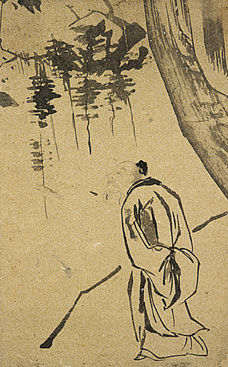|

25¹ø ±èÈ«µµÀÇ
¼ÛÇϼ±ÀÎÃë»ýµµ°¡ ¾øÀ½
|
111 |
 |
 |
 |
| 11111111111111 |
|
еη߳ó¬ÛÉÜóãÇ êÅÓÑô¢ï·ãéÌëá -Óªê®
|
| |
\From
Kimhae, Kim Hong-do used the courtesy name of Sa'nung,
and his many sobriquets included Soho, Tanwon, Tan'gu,
Ch'wihwasa, and Komyonkosa. Based on recent research,
his death date has been amended to around 1806 from the
previously accepted date of after 1818. It would not be
an exaggeration to call Kim Hong-do the representative
artist of the Choson dynasty, given his mastery of¡°true-view¡±
landscapes, genre paintings, Taoist and Buddhist figure
paintings, portraits, bird-and-flower paintings, and other
genres of which he left behind many distinguished and
excellent examples. In addition to receiving the support
of Kand Se-hwang, who was highly influential in the art
world of the late 18th-century, he was highly favored
as a court painter by King Chongjo(1776-1800). Kim was
selected three times to be the painter of royal portraits.
Unhampered by his chung'in social background, was promoted
at the age of forty-six to post of Magistrate of Yonp'ung-hyon
County.
\This
painting depicts an immortal seated on a tilted ground
plane underneath an old pine tree, whose trunk calls to
mind a surging dragon. He is playing the saenghwang(a
wind instrument of bamboo). Kim Hong-do often painted
immortals in his thirties and forties, and although this
painting is not dated, we can place it stylistically to
this period in his life because of the forceful brushstrokes.
The sinuous and organic description of the bark of the
pine tree truly remind the viewer of dragon scales, and
the tree trunk, cut off at the top of the painting, seems
to carry its momentum beyond the picture.
\The
inscription, which seems suspended from the tree, is taken
from a poem by Lo Yeh(active second half of the 9th-century)
collected in the Ch' an-t'ang shih(Complete Poems of the
T\ang Dynasty). It reads as follows:
Short and long bamboo pipes as if a phoenix
has spread its wings,
The notes of the saenghwang, returning to
the moonlit pavilion,
Are more melancholy
than the cries of a dragon.
\From
this we know that the painting depicts a moonlit night,
and from the deeply engrossed expression of the immortal,
we see that his performance is truly as moving and emotional
as described in the poetic inscription. The shadows cast
by the pine needles also evoke a moonlit night, and the
empty spaces in the middle of the painting seem to provide
a serene and boundless arena for the melodies of the saenghwang.
\The
inscription is signed Tanwon, and there is an intaglio
seal reading Sanung. -YSM |
|
| |
|